
Welcome!
Be part of our community & join our international next generation forum now!
Categories
In this Discussion
- brantoken October 2013
- cooperville October 2013
- CothermanDistilling September 2013
- ironman October 2013
- Law_Of_Ohms October 2013
- Lloyd October 2013
- MOD2 November 2013
- Moonshine October 2013
- nvnovrts September 2013
- punkin October 2013
- Smaug October 2013
- Tomer1 November 2013
- troutscout September 2013
Koji and Rice
Koji, or Aspergillus Oryzae (AKA rhizopus oryzae), is used to break down the starches in rice to make sake.
This is all new to me and I could very well be wrong about the above information.
5 packets each weighing 8 grams are sold in the local markets here, called Rice Leaven, and printed in English is the following information:
Angel Yeast Co. LTD.
Ingredients: rice flour, rhizopus oryzae
Directions for use: one sachet pack for 2-2.5kg sticky rice recommended.
1. soak sticky rice in warm water more than 3 hours till crushed easily by hand;
2. cooked by steam, then cool the rice to 35 C, and spread rice leaven on cooked rice;
3. add few cool water and mix, then store in the bowl for 24-36 hours in 30 C;
4. it's ready to eat as wine aroma appears.
Store in a cool and dry place. Shelf life: 18 months
Right, that's obviously for a rice dish I've never had but thinking its the same thing needed to make rice wine and for us to distill.
While biking around today we stopped in at a new 'liquor' store. They sell only what they make in their small shop.
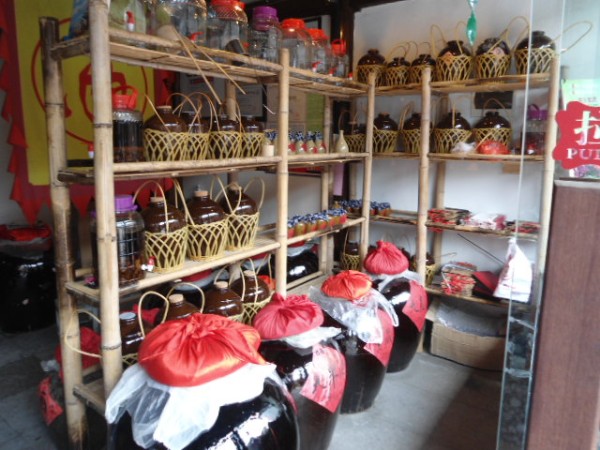
Very typical here is a place to buy Chinese homemade booze and it mostly looks like this. Bring your own container and they will fill it for you.
Priced by the 1/2 Kg (same as 1/2 liter).
But you know me, I gotta poke around... found their still in the back of the shop.
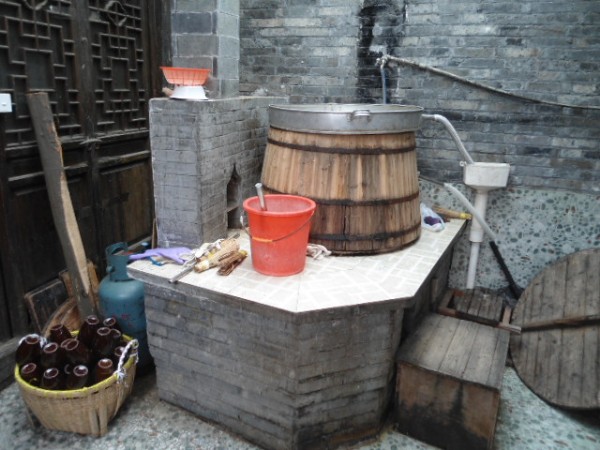
Metal bottom that is fired by propane and the body is wood. The condenser is a pan that has water on top. Tan tells me this is very typical and reminds her of her childhood where once or twice a year the family would gather to make alcohol. She says the same basic design is used everywhere here. The hot water from the condenser pan, she says, was collected to wash clothes and stuff.
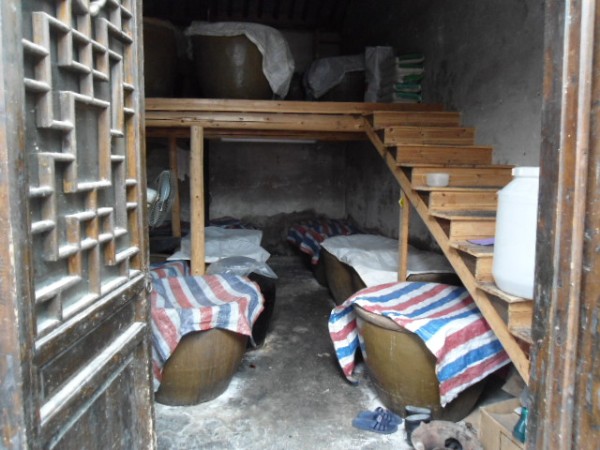
A shot of the fermenter room.
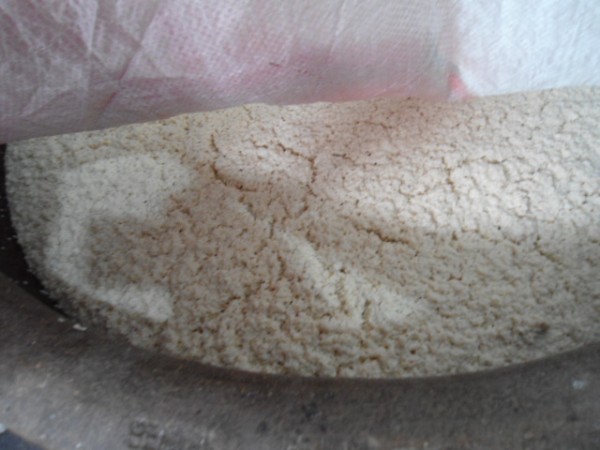
A peek inside a fermenter. Rice wine almost ready to run. Pure white - the rest is just a camera reflection. No noticable smell from the ferment.
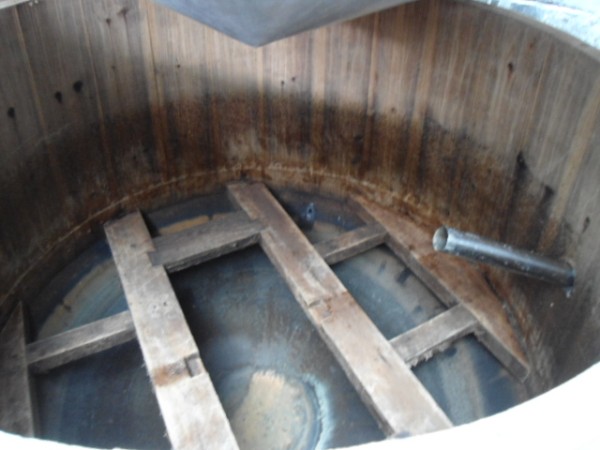
A peek inside the still. Notice the wood bracing? I don't think all of the parts are in place but I was invited to come back tomorrow when the ferment would be ready to run.
I asked about the koji and the lady (still master) was very tight lipped about that saying that it was either powder or liquid and that she used the powder. Beyond that she would not answer because it was considered a trade secret. That too is typical here.
Really hope the weather is good enough tomorrow to return and watch the run but we're still getting strong wind and occasional rain storms from the latest typhoon.

Comments
What a lovely little shop they have. That is what needs to happen here in the States for the craft start ups
StillDragon North America - Your StillDragon® Distributor for North America
PintoShine on AD has several long topics on Koji and distilling rice wine. Just Sayin..... thanx, troutscout
Get To Know Your Koji-kin @ AHB
Really good post here on aussie home brewer too.
Love the look of the shop, clean and tidy and really good use of the space.
StillDragon Australia & New Zealand - Your StillDragon® Distributor for Australia & New Zealand
Great photos, there work space looks professional and tidy I notice a lady is the still master I take it this is common also ? Will you be trying to squeeze more info out of her for the ferm process?
Raining here now but not very hard so we'll go see if she's going to run the still today.
Tan tells me that almost always a woman runs the still while her man goes out to work. "The woman does for the man and he is happy when he comes home".
No idea how the cuts are made since the vast majority of Chinese women do not drink but Tan tells me the first cup is thrown away. She says that she remembers the still to be very slow; as in drop, drop, drop. I'm not sure about that so very curious to actually see it running.
@cooperville, she was very talkative about her still but froze up when asked anything about the ferment. I recon that is the 'trade secret' part.
The StillMaster.
These are aging jars. The tops apparently were sealed off with mud.
The video of the 4" x 9 plate Crystal Dragon was still in the camera so we showed it to her. Within seconds a gaggle of no less than 6 old women were huddled together looking at it. She handed the camera back to us says, "That is an automatic still and we are not interested". Something may have been lost in the translation but you get the jest.
I've been told many times now that anyone can own and use a still in China. Run it in your front yard if you want, no-one cares. A permit is needed if you openly sell the product.
That seems very civilized.
We have returned from seeing the rice wine being distilled and I'm a little disappointed.
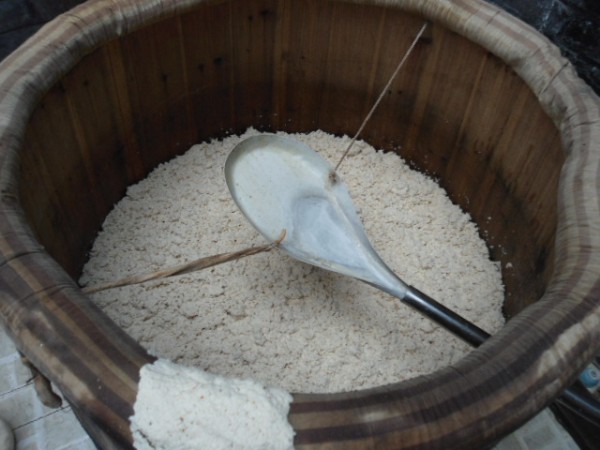
First off, here is the missing piece needed to collect the alcohol...
It looks like a big spoon. It funnels the condensate to the outlet pipe which is hot. They would not allow me to open the plastic bag that helped to seal off the plastic pipe that lead to the plastic collection jug. The collection rate as far as I could tell was VERY slow, just as Tan said it would be. The product was hot in the bottom of the plastic collection jug.
Worse, they made NO cuts at all.
They loaded the still just above the bottom of the wooden sides with a mix of rice and the wine and lit the propane burner. I assume after then they just keep adding more wine and perhaps bail out some spent stillage.
Tan cornered one old lady and asked specifics and gleaned the following:
1 Kg sticky rice to 2 liters of water. A basket was pushed into the center of each fermenter and a large ladle was used to dip the wine from the basket and pour it over the rice. This was done once a day 'for oxygen'.
The rice was used for two ferments and then was used as pig feed.
As a thank you for allowing us to photograph their shop and process I bought a bottle of their finest booze. I don't really notice the heads but the tails are quite evident. It proudly advertises that it is aged one full year. Tan looked at me and asked, "You don't really believe that, do you?"
Ha hah very funny amazing how people create their own product only to bite themselves with a lack of education
It makes me want to invite them to my home to see how it is really done but they satisfy a market that expects the booze to taste like that.
A vendor came by about a year ago and I gave him a drink of my white at about 45% ABV. He said it tasted like water. I took it as a compliment but in fact it was not. He never had clean alcohol before and without the tails and the heat I guess it didn't taste like booze to him.
So they intentionally make and drink booze that cause you nasty headache the next day? Then it's no wonder it's said the Chinese have an alcohol intolerance. :-O
Your Place to be >>> www.StillDragon.org <<< Home of the StillDragon® Community Forum
Perhaps the bad likker protects them from a genetic Predisposition?
StillDragon North America - Your StillDragon® Distributor for North America
I guess its several factors involved in the intolerance to alcohol that afflicts a portion of the population. One is the body weight or mass of the individual and generally Asians are smaller and leaner than their western counterparts so it takes less alcohol to achieve the same state of inebriation.
Also, this article can help to explain the genetic mutation that affects about 25% of the Asian population (mostly of Han decent).
I personally have helped to compensate for those that are alcohol intolerant.
List of countries by alcohol consumption per capita.
I'm starting to experiment with the rice and koji.
The picture shows several kinds of rice. On the left is typical round rice that is commonly available here. On the right is long grain rice that most westerners are familiar with, it is more expensive here. In the center is sticky rice that the recipe calls for. It also called glutinous rice.
After soaking 14Kg of sticky rice in warm water for 3 hours and we're cooking the first batch now with our 2 little rice cookers. This might take awhile.
I plan to use 7Kg of rice in each of two 25L fermenters.
Will keep you posted on the results, good or bad.
Sugar and fruit are crazy expensive here but booze, rice wine and rice are cheap.
I bought 14Kg of the rice today for about $13 USD and 18.5 liters of 12% ABV rice wine for about $10. The rice wine tasted surprisingly OK. I distilled it and discarded about 300 ml fores and heads and kept almost 1300 ml of 94%. Another 1 liter of tails were collected for recycle at about 50% ABV. So I finished up with about 3 liters of 45% of acceptable booze for $10 of 'feedstock'. That will help me to compare the economics of buying and fermenting rice.
watch these two videos by basic brewing.. you will be glad you did..
Basic Brewing Radio goes to Sake One!
The thought of Rice "whiskey" makes me shudder. Mekong from Thailand mixed with Pepsi.... The Horror, The Horror...
and this is a good read on starting up sake koji correctly... and he does a lot of other things... hence the nickname 'the mad fermentationist'
Making Koji for Sake
This is a great thread guys I to am very interested in the thought of using rice as our base starch contributor Having been to a sake brewery and seeing the simplicity on a larger scale The thought of running a wash of fine rice wine to complete a neutral is really appealing
I discovered last night that my rice cookers are not rated for continuous duty; after the first 3 batches (and at 9 PM) they both refused to work again unless they were allowed an hour rest to cool down. So we cooked batches on the stovetop and scorched the bottom of one 2Kg batch and that had to be tossed out.
This made a thick porridge in both of my 25L fermenters, nothing like the old ladies' ferments were the rice was still intact. I'm thinking they did not cook their rice. After the 3 hour soak in warm water the grains were probably soft enough to use as is.
This is a very sticky mess that has rested in the bathtub overnight in a water bath to help it cool down. I fear this goo, unless it really breaks down a lot, will be impossible to distill.
The koji and yeast will be added today. This sticky goop in the fermenters is a bit unnerving.
3 packets of koji and 2 packets of champagne yeast (only think I have except baker's) were added and the goo was stirred as best as I could do. I'll stir once a day and report back if I need to find a landfill to dispose of this mess or not.
what i know is that the rice for sake is definitely steamed and not boiled as boiling like you know will create porridge or stodge as i like to call it I admire your sense of adventure Damn shame bout the rice cookers it's what I was planning to try with also Rice leaven hey thats nice to know did you get that from a super market ?
@cooperville, yes, the rice leaven or koji stuff is easy to get here at any supermarket.
Cheap too at only about 16 US cents per packet.
Most of the rice was steamed before the rice cookers went on strike. Since it was already hydrated it took very little cooking time.
I may have approached this experiment the wrong way... perhaps it would have been better to make many, smaller batches and each one different; different kinds of rice, yeast, some cooked, some uncooked (but simply hydrated for 3 to 5 hours). Probably just a bit anxious to fill the fermenters again because it's been a long while.
I think this method is how I would have started also could be a good lesson hopefully we can get some sg and fg figures to see how you went once that koji does its job Will you be fermenting on or off the grain And or filtering before distillation?
I reckon the leaven could be good for the web site ? I would get a couple of packs ;)
Coop, @Law_Of_Ohms assures me that this paste will liquefy. If so I'll take a gravity reading. It will be interesting to see the actual yield from 12Kg (was 14Kg but I scotched 2) of rice.
The 12% ABV rice wine I bought yesterday and ran through the 9 plates has a very light, pleasant flavor. Quite nice for vodka. About half way through I disabled the dephlegmator and ran in pot still mode. The flavor was not really to my liking.
I bet you can find it in Japan; like me you probably don't recognize it when you see it. I looked at those packets at least once every other month for two years before investing that $1 :))
**Edited to spell liquefy correctly :\">
I did a 'quick' experiment last night.
After batch 'sparging' and adding extra water to the rice glue and bringing back to boil, and pressing the 'cake'.
I got 3L @ 1.045
F-loads of work.
With the 'koji' method you just steam the rice, put in the fermenter, add the 'koji' or 'chinese yeast balls' and wait...... (1 month?)
There is a chap who makes Hmong rice spirits...
http://www.youtube.com/watch?v=e-JYs8uX_r8
If you watch some of his vids on youtube he shows some of the fermenters that have aged ~8 months before distilling.
http://www.youtube.com/watch?v=hhZq2R57jMQ
I think there is 'something' in making spirits from a 'wine' base that has aged.
https://www.youtube.com/watch?v=ty6eY9VUIgI
I bet you are right LoO. I have run some aged rum beer and had some pretty spactacular results.
StillDragon North America - Your StillDragon® Distributor for North America
After only one day the ferment is not a thick sticky paste. It is a thin sticky paste. A bit like Elmer's glue. Law of Ohms might be right after all, give it time and it thins out. Light at the end of the tunnel. Clear skies or train crash? Let's give it a week to find out (although the old ladies said their ferments were 3 days, 4 tops).
Hello, friends!
In 2012, I began research on the saccharification of various grains with Chinese koji enzymes. Koji in the already contain yeast. Cooking the grain is not necessary, but you can cook, then fermentation will be faster. A lot of information, but if you're interested and have the desire to get more information about the work done by me, you can, with the help of google translator, read the information and photos of the Russian-speaking forum. This information will help to quickly start using the new Chinese technology is not stepping on my rake ;-)
Cold saccharification and fermentation of starch-containing raw materials (Chinese koji) @ forum.homedistiller.ru
Sorry for my bad English.
If the information does not correspond to the rules - delete my message.
@ironman, Hello & Welcome, your participation here in our community is very much appreciated! We have no problems referencing to other sources and forums on the Internet (I wish other forums would be that tolerant as well). I hope you don't mind that I uploaded your pictures to your comment, we like to have it all here in case the external source becomes unavailable.
Have a look around & have fun, our user group is a great place to be, it's not limited to StillDragon products, we strive for more. ;)
Your Place to be >>> www.StillDragon.org <<< Home of the StillDragon® Community Forum
It's OK & thanks! Oh my bad English ))) But if you have questions about using koji and my information on the Russian forum is not fully understood, I can detail here to answer questions.
Your English is quite good, so don't worry, we are a global community with a lot of non-native English speaking participants.
I'm sure the others will love to read more from you about Koji, translation from Russian does not always work properly, often the output is not really clear.
Your Place to be >>> www.StillDragon.org <<< Home of the StillDragon® Community Forum